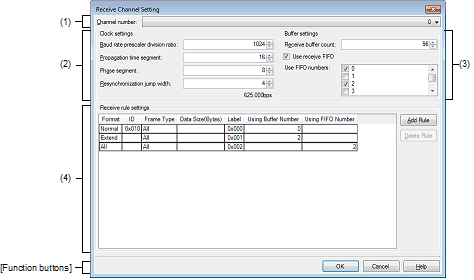|
Receive Channel Setting dialog box [Full-spec emulator][E1][E20] |
This dialog box is used to make settings related to the receive channel shown in the Debugging CAN Bus Reception Procedures panel [Full-spec emulator][E1][E20].

This section describes the following.
On the Debugging CAN Bus Reception Procedures panel [Full-spec emulator][E1][E20], click the [Receive Channel Setting...] button on the toolbar. |
Select the channel for which debugging of CAN bus reception is to be performed.
See the hardware manual for channels that have RS-CAN units.
Set the reception clock to determine the reception speed.
The value of the reception speed is calculated from the following settings and is displayed at the bottom of this area.
Specify the frequency division ratio of the baud rate prescaler as a decimal value from 1 to 1024.
Specify the time unit of a propagation time segment as a decimal value from 4 to 16.
Specify the time unit of a phase buffer segment as a decimal value from 2 to 8.
Specify the time unit of the resynchronization jump width as a decimal value from 1 to 4.
See "2.25 Debugging CAN Bus Reception Procedures [Full-spec emulator][E1][E20]" for details on calculating the receive speed.
Make settings related to the receive buffers and receive FIFOs which are used in the receive channel.
Specify the number of receive buffers as a decimal value from 0 to (Number of channels of units * 16).
If 0 is specified, receive buffers are not used.
Buffer numbers from 0 to (Number of specified buffers - 1) are assigned to receive buffers.
Specify whether receive FIFOs are to be used.
This item which displays a list of receive FIFO numbers appears only when the [Use receive FIFO] check box is selected.
Select the receive FIFOs you wish to use from the list.
Set the receive rules that are to be applied to the receive channel.
The receive rules that have already been set are listed.
Each item can be selected via the drop-down list or edited directly.
Each item is explained as follows:
Select the format of the frames to be received from the following drop-down list.
Specify the ID values of the frames to be received as hexadecimal values.
Only the frames that match the specified ID values are received. If this item is blank, frames of all ID values are received.
The specifiable range of the hexadecimal value for the ID value depends on the format as shown below. |
When the value of the format was changed to "Extend" or changed from "All" to "Normal", a value filtered by 0x7FF is automatically set. |
Select the type of the frames to be received from the following drop-down list.
Specify the data size (bytes) of each frame to be received within the range of 1 to 8 bytes.
If this is blank, frames of all data sizes are received.
When the value of the frame type was changed to "Data" or changed from "All" to "Remote", this item is left blank automatically. |
Specify the label value to be added to the frames that have passed the conditions of <1> to <4>.
The label value should be a hexadecimal value from 0 to 0xFFF.
Specify the receive buffer number for storing the frames that have passed the conditions of <1> to <4>.
The following values can be specified.
|
Decimal value from 0 to ([Receive buffer count] setting - 1) |
Frames are stored in the buffer with the specified receive buffer number. |
When the value of the storage FIFO number is changed from blank to a number, this item is made blank automatically. |
Specify the receive FIFO number for storing the frames that have passed the conditions of <1> to <4>.
The following values can be specified.
|
Decimal value of [Use FIFO numbers] that can be used |
Frames are stored in the FIFO with the specified receive FIFO number. |
When the value of the storage buffer number is changed from blank to a number, this item is made blank automatically. |
The default values of receive rules are as follows:
|
Adds a new receive rule to the receive rule list. A newly added rule has the default values (see "(b) Default values of receive rules"). |
|
|
Reflects the settings of the receive channel that were set in this dialog box to the [Receive channel settings] area on the Debugging CAN Bus Reception Procedures panel [Full-spec emulator][E1][E20]. |
|